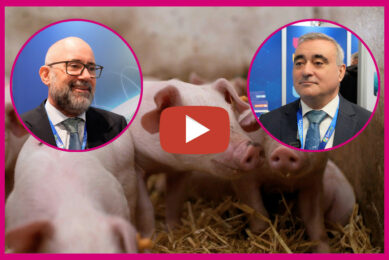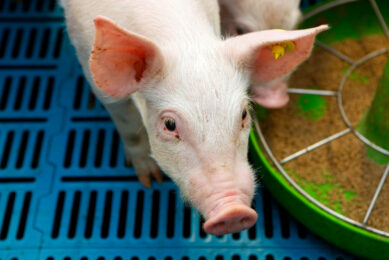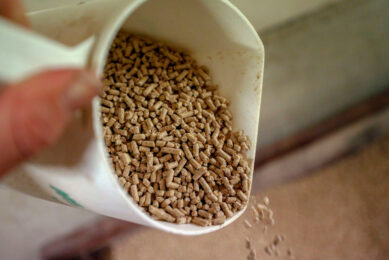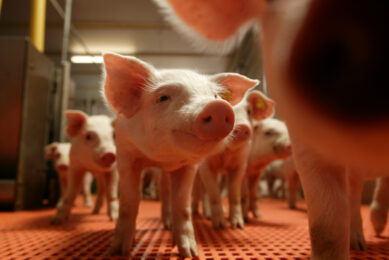Do microbes affect performance?
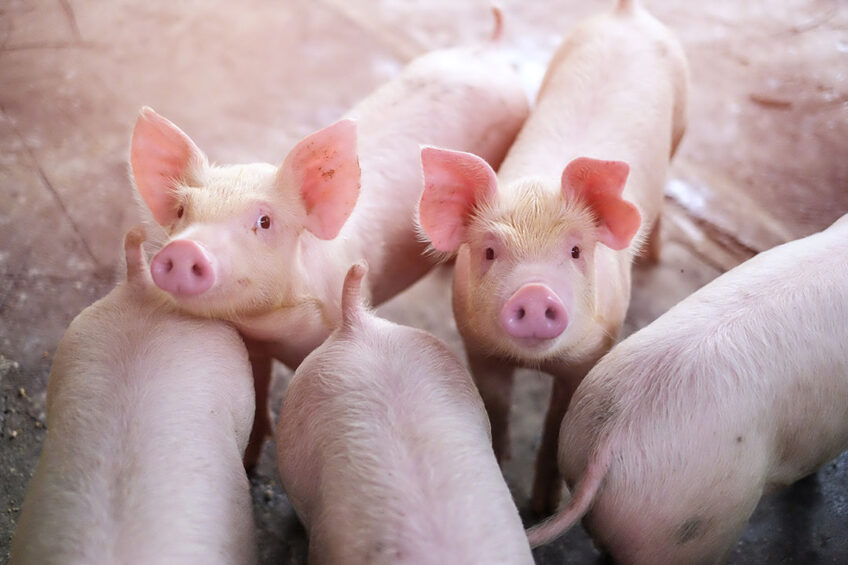
YES, they do. For piglets, a proper gut health status is crucial for reaching optimal results. In the digestive tract, the microflora is largely determining the gut health status and the linked zootechnical results. Balancing the microflora will result in better production figures.
Currently, modern techniques are used, like 16s rRNA sequencing, to measure large quantities of bacteria and biochemical molecules. Using this technique, we can identify the factors regulated by the gut microflora and how these factors are influenced by antibiotics, nutrition, and diseases. This helps to explain the correlation between the gut microbiome and the performance of piglets.
The positive impact of good microbiota
In recent trials the effects of yeast probiotic Actisaf Sc47 (hereafter called ‘yeast probiotic’) on the composition of the gut microflora, the interrelationships between present bacteria and the performance were evaluated. Research on the microbiome has been conducted on half of the piglets while the other half were followed measuring performance parameters. The results confirmed that the yeast probiotic fed piglets had a more homogenous microbiome compared to the control group. After proving the change in microbiome, the inter-relationships between the present bacteria were further investigated. A positive inter-relationship means that the classes of bacteria are not competing for nutrients or space, balancing in co-occurrence. A negative inter-relationship will lead to competition for nutrients and space leading to a sensitive disbalance. This disbalance makes the gut flora vulnerable for changes. The more positive inter-relations, the lower the chance for harmful bacteria to develop. Using a CoNet analysis, Kiros has demonstrated that Actisaf Sc47 is positively influencing the inter-relationships between the present bacteria: the control group had a positive:negative ratio of 0.99 whereas the yeast probiotic fed piglets had a ratio of 2.31.
From these results we conclude that Actisaf Sc47 is developing a more resilient gut microflora and support a positive inter-relationship of mainly the classes Firmicutes (e.g. Lactobacillus and Eubacterium) and Actinobacteria (e.g. Bifidobacterium).
Figure 1 – Performance results of piglets fed with Actisaf Sc47.
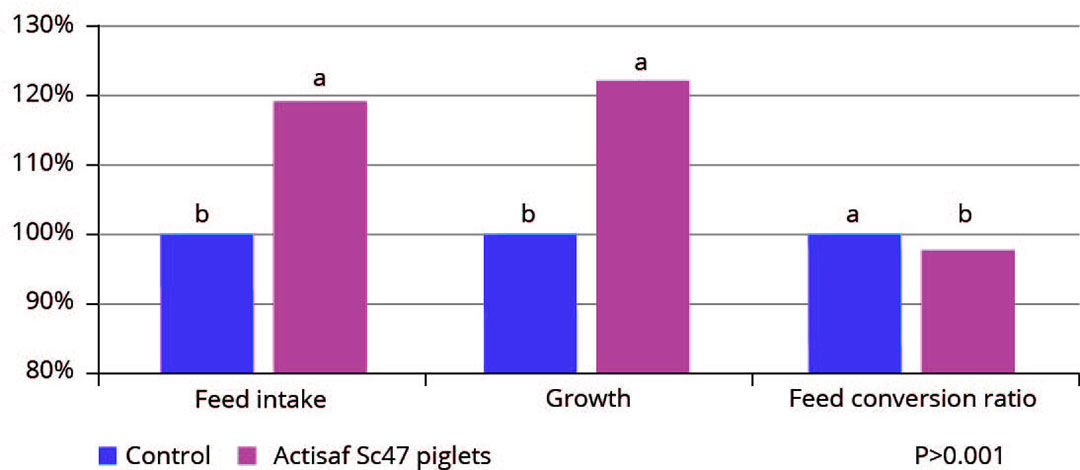
To judge whether these changes in microbiome had a positive effect on the piglets a closer look was taken at the performance parameters measured. The piglets had been followed up to the age of 56 days. The main parameters measured were feed intake and average daily gain from which the feed efficiency has been calculated. Piglets fed Actisaf Sc47 showed a 2kg increase of final body weight over the control group (Figure 1). The study confirmed results from other trials conducted focusing on the effects of the yeast probiotic on the performance of piglets. Now however, we have also demonstrated how these effects can be explained: the microbiome is better balanced improving the gut health status.
Negative impact of pathogens
One of the main issues right after weaning is the reduced and irregular feed intake of piglets. This leads to disrupted gut development creating opportunities for potential pathogens like E. coli and Streptococcus suis to cause further damage. To avoid this, a high-quality diet should be fed with emphasis on protein digestibility, fibre content and feed palatability.
For piglets to cope with the changing diets, it is important to support the microbiome development. The microbial population present in the digestive tract of young piglets is sensitive to stresses caused by for example feed changes or weaning. Bacteria are competing for available space and nutrients leading to digestive disorders such and diarrhoea. Aiming for a robust and diverse community is key to avoid these digestive problems. As explained above, the yeast probiotic is known for its positive impact on piglet microbiome development. Supplementing the yeast probiotic to piglets leads to higher concentrations of beneficial bacteria and on top of that it leads to a more harmonious environment and lower sensitivity to stresses. Consequently, there is lower occurrence of digestive disorders reducing the needs for any treatments with for example antibiotics.
Although the probiotic effect of Actisaf, improving the microbiome, does start right after supplementation, the full impact can only be observed after some time. Therefore, it is important to help piglets to bridge this period of adaptation to limit the risk of pathogens like E. coli to cause a health issue.
To have immediate impact on pathogen control the use of Safmannan (hereafter called ‘yeast postbiotic’) is recommended. This premium yeast fraction acts as a magnet to bacteria like E. coli. Due to the high concentration of MOS these bacteria adhere to Safmannan with their mannose sensitive fimbriae preventing causing an inflammation. Once bacteria are bound to the yeast postbiotic no further harm will be done as they are excreted in the faeces.
A new era
Although improvement of management processes can contribute to reducing the need for zinc oxide, various studies have shown that, even already without these management improvements, the combination of Actisaf and Safmannan proofs to be a promising alternative to the therapeutic use of zinc oxide. Yeast supplemented piglets often reach similar performance levels compared to piglets receiving high zinc oxide. On top of that, no extra antibiotics or other treatments were required during the rearing stage.
Figure 2 – Summary of trials with weaned piglets comparing
therapeutic zinc supplementation with a combination of Actisaf and Safmannan.
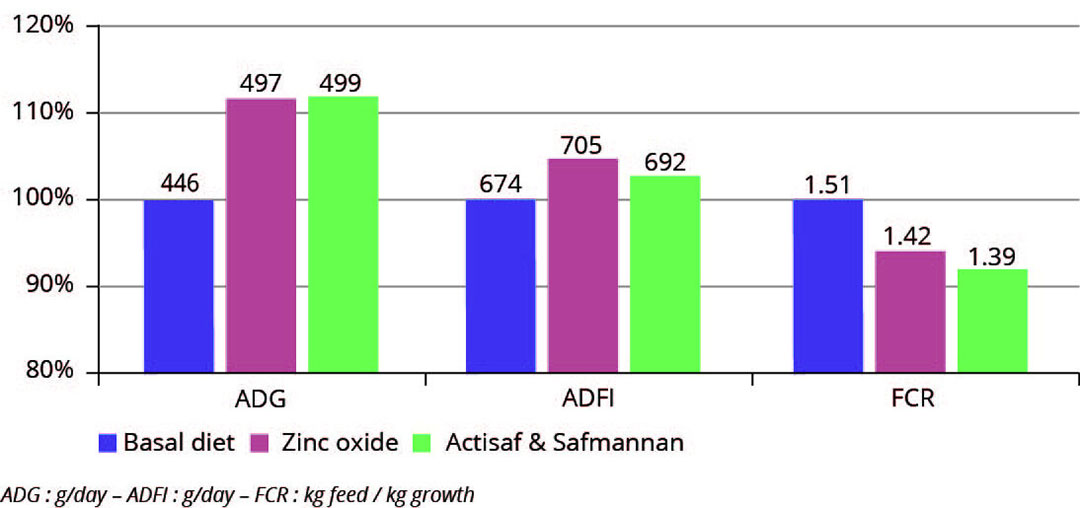
A synthesis of results from three trials recently conducted in Europe show the impact of zinc oxide on the performance of piglets (Figure 2). The results of piglets supplemented with the yeast probiotic and the yeast postbiotic are very similar to the ones supplemented with therapeutic zinc oxide.
The overall performance of piglets during the six-week rearing period were similar between high zinc oxide supplemented groups and piglets that received the yeast probiotic and the yeast postbiotic.
During trials, treatments with antibiotics were also recorded. In none of the trials a significant difference was observed in number of treatments between groups supplemented with therapeutic zinc oxide and groups supplemented with a combination of Actisaf and Safmannan.
Even though improving management practices on farm remains key, therapeutic doses of zinc in weaner diets can be eliminated with a close eye on feed intake of young piglets, microbiome development and pathogen control.



